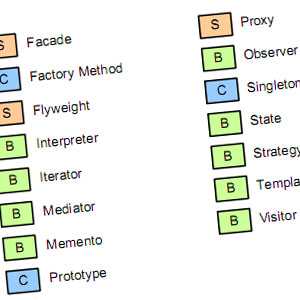
Composite pattern
Information drawn from
This is a structural design pattern that composes objects into tree-like structures to represent whole-part hierarchies. In this pattern, each node in the tree-like structure can be either an individual object or a composed collection of objects. Regardless, each node is treated uniformly.
It is a bit complex to visualize this pattern. The easiest way to think about this is with the example of a multi-level menu. Each node can be a distinct option, or it can be a menu itself, which has multiple options as its child. A node component with children is a composite component, while a node component without any child is a leaf component.
In this example, we create a base class of Component that implements the common functionalities needed and abstracts the other methods needed. The base class also has a static method that utilises recursion to traverse a composite tree structure made with its subclasses. Then we create two subclasses extending the base class , Leaf that does not have any children and Composite that can have children, and hence have methods handling adding, searching, and removing child functionalities. The two subclasses are used to create a composite structurem, a tree, in this case.
class Component {
constructor(name) {
this._name = name;
}
getNodeName() {
return this._name;
}
// abstract methods that need to be overridden
getType() {}
addChild(component) {}
removeChildByName(componentName) {}
removeChildByIndex(index) {}
getChildByName(componentName) {}
getChildByIndex(index) {}
noOfChildren() {}
static logTreeStructure(root) {
let treeStructure = '';
function traverse(node, indent = 0) {
treeStructure += `${'--'.repeat(indent)}${node.getNodeName()}\n`;
indent++;
for (let i = 0, length = node.noOfChildren(); i < length; i++) {
traverse(node.getChildByIndex(i), indent);
}
}
traverse(root);
return treeStructure;
}
}
class Leaf extends Component {
constructor(name) {
super(name);
this._type = 'Leaf Node';
}
getType() {
return this._type;
}
noOfChildren() {
return 0;
}
}
class Composite extends Component {
constructor(name) {
super(name);
this._type = 'Composite Node';
this._children = [];
}
getType() {
return this._type;
}
addChild(component) {
this._children = [...this._children, component];
}
removeChildByName(componentName) {
this._children = [...this._children].filter(component => component.getNodeName() !== componentName);
}
removeChildByIndex(index) {
this._children = [...this._children.slice(0, index), ...this._children.slice(index + 1)];
}
getChildByName(componentName) {
return this._children.find(component => component.name === componentName);
}
getChildByIndex(index) {
return this._children[index];
}
noOfChildren() {
return this._children.length;
}
}
// usage
const tree = new Composite('root');
tree.addChild(new Leaf('left'));
const right = new Composite('right');
tree.addChild(right);
right.addChild(new Leaf('right-left'));
const rightMid = new Composite('right-middle');
right.addChild(rightMid);
right.addChild(new Leaf('right-right'));
rightMid.addChild(new Leaf('left-end'));
rightMid.addChild(new Leaf('right-end'));
// log
console.log(Component.logTreeStructure(tree));
/*
root
--left
--right
----right-left
----right-middle
------left-end
------right-end
----right-right
*/
------------------------------------------------------------------------
Last update on 15 Jun 2020
---